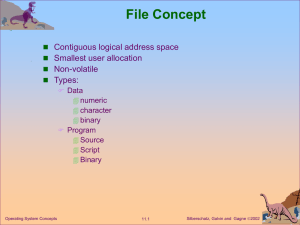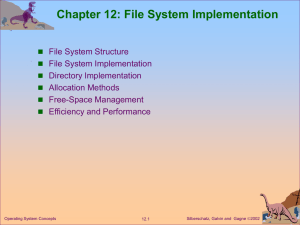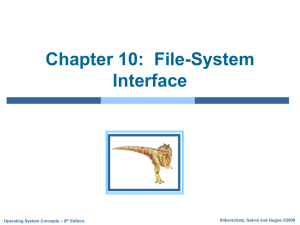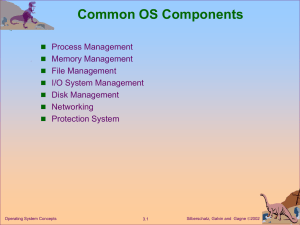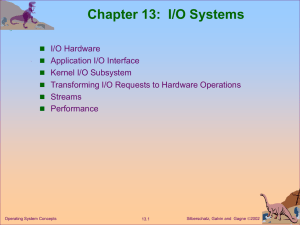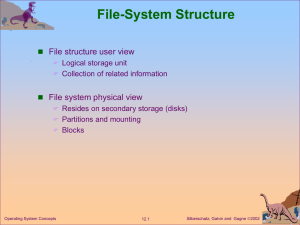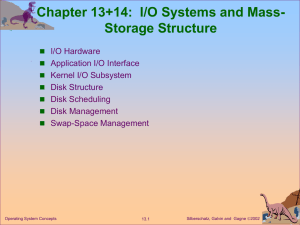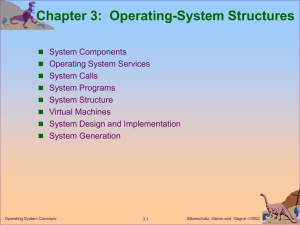File-System Interface
advertisement
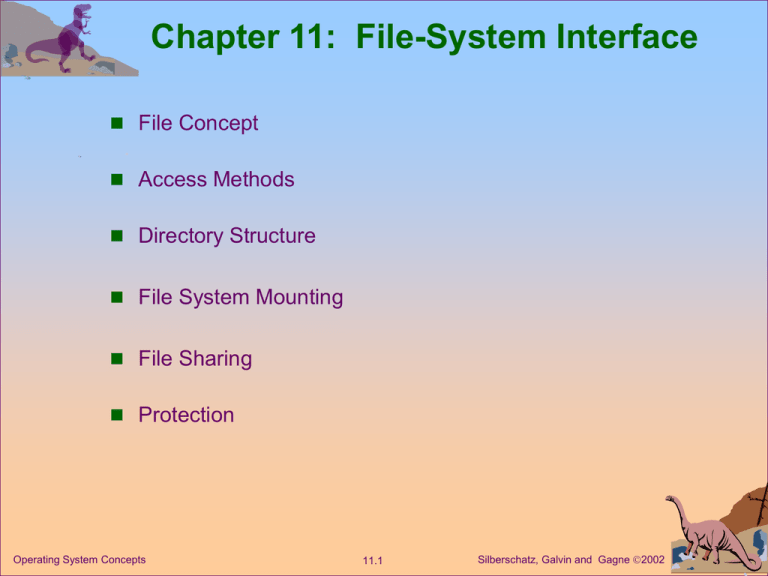
Chapter 11: File-System Interface File Concept Access Methods Directory Structure File System Mounting File Sharing Protection Operating System Concepts 11.1 Silberschatz, Galvin and Gagne 2002 File Concept Contiguous logical address space Types: Data numeric character binary Program Operating System Concepts 11.2 Silberschatz, Galvin and Gagne 2002 File Structure None - sequence of words, bytes Simple record structure Lines Fixed length Variable length Complex Structures Formatted document Relocatable load file Can simulate last two with first method by inserting appropriate control characters. Who decides: Operating system Program Operating System Concepts 11.3 Silberschatz, Galvin and Gagne 2002 File Attributes Name – only information kept in human-readable form. Type – needed for systems that support different types. Location – pointer to file location on device. Size – current file size. Protection – controls who can do reading, writing, executing. Time, date, and user identification – data for protection, security, and usage monitoring. Information about files are kept in the directory structure, which is maintained on the disk. Operating System Concepts 11.4 Silberschatz, Galvin and Gagne 2002 File Operations Create Write Read Reposition within file – file seek Delete Truncate Open(Fi) – search the directory structure on disk for entry Fi, and move the content of entry to memory. Close (Fi) – move the content of entry Fi in memory to directory structure on disk. Operating System Concepts 11.5 Silberschatz, Galvin and Gagne 2002 File Types – Name, Extension Operating System Concepts 11.6 Silberschatz, Galvin and Gagne 2002 Access Methods Sequential Access read next write next reset no read after last write (rewrite) Direct Access read n write n position to n read next write next rewrite n n = relative block number Operating System Concepts 11.7 Silberschatz, Galvin and Gagne 2002 Sequential-access File Operating System Concepts 11.8 Silberschatz, Galvin and Gagne 2002 Simulation of Sequential Access on a Direct-access File Operating System Concepts 11.9 Silberschatz, Galvin and Gagne 2002 Example of Index and Relative Files Operating System Concepts 11.10 Silberschatz, Galvin and Gagne 2002 Directory Structure A collection of nodes containing information about all files. Directory Files F1 F2 F3 F4 Fn Both the directory structure and the files reside on disk. Backups of these two structures are kept on tapes. Operating System Concepts 11.11 Silberschatz, Galvin and Gagne 2002 A Typical File-system Organization Operating System Concepts 11.12 Silberschatz, Galvin and Gagne 2002 Information in a Device Directory Name Type Address Current length Maximum length Date last accessed (for archival) Date last updated (for dump) Owner ID (who pays) Protection information (discuss later) Operating System Concepts 11.13 Silberschatz, Galvin and Gagne 2002 Operations Performed on Directory Search for a file Create a file Delete a file List a directory Rename a file Traverse the file system Operating System Concepts 11.14 Silberschatz, Galvin and Gagne 2002 Organize the Directory (Logically) to Obtain Efficiency – locating a file quickly. Naming – convenient to users. Two users can have same name for different files. The same file can have several different names. Grouping – logical grouping of files by properties, (e.g., all Java programs, all games, …) Operating System Concepts 11.15 Silberschatz, Galvin and Gagne 2002 Single-Level Directory A single directory for all users. Naming problem Grouping problem Operating System Concepts 11.16 Silberschatz, Galvin and Gagne 2002 Two-Level Directory Separate directory for each user. •Path name •Can have the same file name for different user •Efficient searching •No grouping capability Operating System Concepts 11.17 Silberschatz, Galvin and Gagne 2002 Tree-Structured Directories Operating System Concepts 11.18 Silberschatz, Galvin and Gagne 2002 Tree-Structured Directories (Cont.) Efficient searching Grouping Capability Current directory (working directory) cd /spell/mail/prog type list Operating System Concepts 11.19 Silberschatz, Galvin and Gagne 2002 Tree-Structured Directories (Cont.) Absolute or relative path name Creating a new file is done in current directory. Delete a file rm <file-name> Creating a new subdirectory is done in current directory. mkdir <dir-name> Example: if in current directory /mail mkdir count mail prog copy prt exp count Deleting “mail” deleting the entire subtree rooted by “mail”. Operating System Concepts 11.20 Silberschatz, Galvin and Gagne 2002 Acyclic-Graph Directories Have shared subdirectories and files. Operating System Concepts 11.21 Silberschatz, Galvin and Gagne 2002 Acyclic-Graph Directories (Cont.) Two different names (aliasing) If dict deletes list dangling pointer. Solutions: Backpointers, so we can delete all pointers. Variable size records a problem. Backpointers using a daisy chain organization. Entry-hold-count solution. Operating System Concepts 11.22 Silberschatz, Galvin and Gagne 2002 General Graph Directory Operating System Concepts 11.23 Silberschatz, Galvin and Gagne 2002 General Graph Directory (Cont.) How do we guarantee no cycles? Allow only links to file not subdirectories. Garbage collection. Every time a new link is added use a cycle detection algorithm to determine whether it is OK. Operating System Concepts 11.24 Silberschatz, Galvin and Gagne 2002 File System Mounting A file system must be mounted before it can be accessed. A unmounted file system (I.e. Fig. 11-11(b)) is mounted at a mount point. Operating System Concepts 11.25 Silberschatz, Galvin and Gagne 2002 (a) Existing. (b) Unmounted Partition Operating System Concepts 11.26 Silberschatz, Galvin and Gagne 2002 Mount Point Operating System Concepts 11.27 Silberschatz, Galvin and Gagne 2002 File Sharing Sharing of files on multi-user systems is desirable. Sharing may be done through a protection scheme. On distributed systems, files may be shared across a network. Network File System (NFS) is a common distributed file- sharing method. Operating System Concepts 11.28 Silberschatz, Galvin and Gagne 2002 Protection File owner/creator should be able to control: what can be done by whom Types of access Read Write Execute Append Delete List Operating System Concepts 11.29 Silberschatz, Galvin and Gagne 2002 Access Lists and Groups Mode of access: read, write, execute Three classes of users RWX a) owner access 7 111 RWX b) group access 6 110 RWX c) public access 1 001 Ask manager to create a group (unique name), say G, and add some users to the group. For a particular file (say game) or subdirectory, define an appropriate access. owner chmod group 761 public game Attach a group to a file chgrp Operating System Concepts G 11.30 game Silberschatz, Galvin and Gagne 2002
